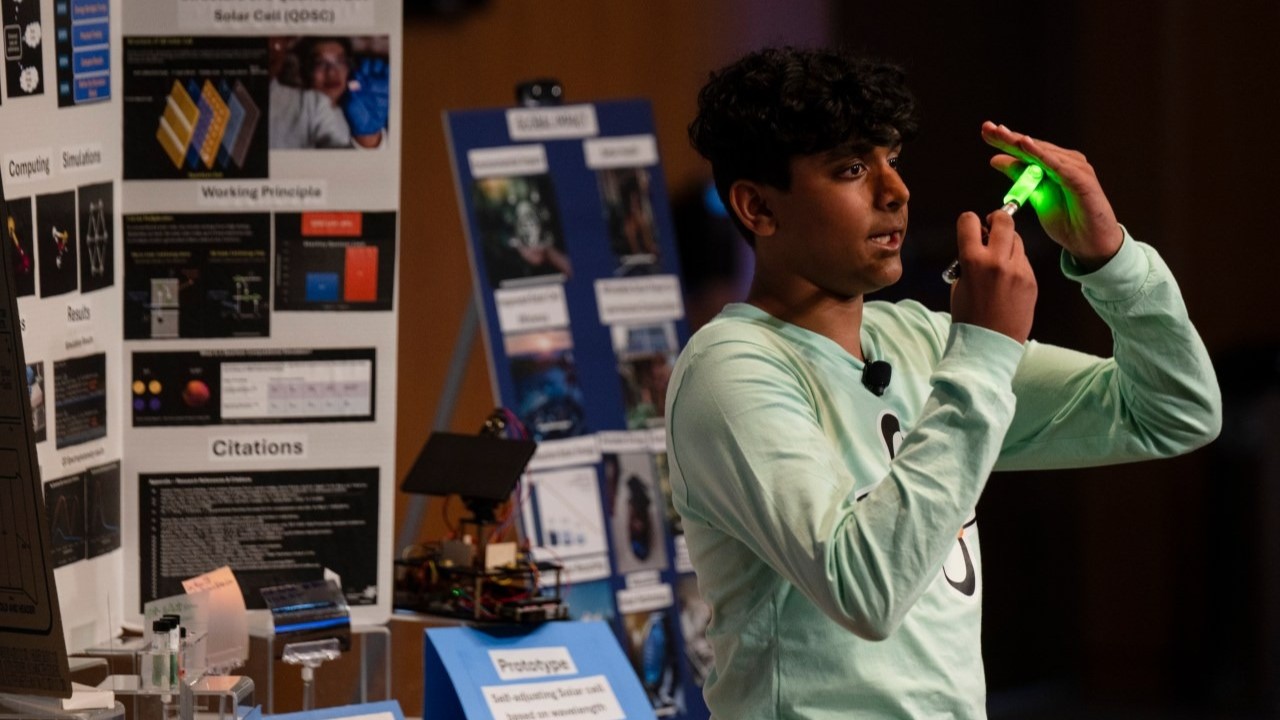
Young scientists showcase problem-solving projects at 3M in Maplewood
Aakash Manaswi stood in a beekeeper’s apiary five years ago, pummeling the keeper with question after question, including the one that would inspire him to invent a solution years later: Why were half of the bee hives in decline and the other half empty?
“Bees are the most important species on our planet,” Manaswi, 15, said, citing research that they are responsible for over 80% of global crop pollination.
Because of that — and his love for food — Manaswi wanted to solve the issue. He found out a parasite called the Varroa mite was killing bees by latching itself onto their bodies and depleting their body fat.
“It’s a really big issue,” Manaswi said.
His solution: a novel CO2 treatment that kills the parasite and keeps the bees safe, with a 98% bee survival rate and no long-term harm to the hive.
Manaswi presented his creation Tuesday during 3M and Discovery Education’s 17th annual Young Scientist Challenge at the 3M Innovation Center in Maplewood. The program selects 10 middle school finalists from across the country to partner with a 3M scientist to further develop and present a project that addresses a real world challenge, like Manaswi’s “Mite-blower.”
“Our mission at Discovery Education is to create learning experiences that bring the content that students are learning in the classroom to the real world, and there’s no better venue than an event like this,” CEO of Discovery Education Brian Shaw said.
Interested middle schoolers submit a project proposal video and, if selected as finalists, they are paired with mentors who help them develop their projects with weekly check-ins throughout the summer.
In October they compete in Minnesota, where the winner receives $25,000 and is named “America’s top young scientist.”
Last year’s winner, Time magazine’s “Kid of the year” Hemen Bekele, developed a soap to help treat skin cancer.
Other finalists have created businesses and received patents for their projects.
The competition
The competition began Monday, as the young scientists met one another and their mentors for the first time after months of Zoom meetings. Finalist William Tan, 14, said it was like meeting with old friends.
They completed their first challenge, working together with another finalist on an inventive task, judged by 3M employees on their collaborative abilities and innovation.
Related Articles
Former Forest Lake band director and wife killed in Carver County crash
Bethel University announces $20 million donation, launch of new health sciences college
Wisconsin Supreme Court grapples with governor’s 400-year veto, calling it ‘crazy’
St. Paul school board hears what community members want in a new superintendent
Q&A: How an obsession with Girl Scout cookies turned into a new youth leadership program
They also were given a tour of the 3M Innovation Center and the opportunity to connect with 3M scientists.
“It’s really eye opening in the world of science,” Tan said.
Tan, from New York, said he’s always had a love for sailing. While sailing in the ocean he noticed that the oyster reefs seemed empty. After doing more research he found out that since the 1950s, more than 50% of all coral reefs have been lost.
“This is a really big issue because it could cost upwards of $14 trillion by the end of the century if it’s not solved,” Tan said.
A current solution to this problem is artificial reefs, though Tan said many of these artificial reefs are really just junk like old car tires thrown into the ocean, disguised as a smart alternative. His project is a 3D printed structure which uses biodegradable and non-toxic PLA plastic, coated with a special oyster mixture that mimics natural reefs and promotes biodiversity.
“I think the biggest thing to remember, especially for young people, is that you can do anything you put your mind to,” 3M product engineer and Tan’s mentor Deborah Isabelle said.
Hanna Suzuki, 14, talks about her Audio Augmentation for Celestial Objects: Sonifying Constellations and Mapping their Sound Logos onto the Night Sky project. (John Autey / Pioneer Press)
Hanna Suzuki, 15, of Bedford, Mass., created a sky mapping device that uses musical scores to identify constellations, which she named “Astro sound box.”
“Sonification blended two of my greatest interests, astronomy and music,” Suzuki said.
Suzuki has been interested in astronomy and constellations for years. She said her family goes camping often and, at night, she would find the stars fascinating. Three years ago she learned about sonification, the process of translating images to sound, from a NASA project and applied the idea in her own work.
The Astro sound box is not simply a fun idea for Suzuki. She believes that her invention can help the visually impaired experience astrology in a new way and attract others to the world of science and technology.
“I think this is a really great opportunity, I’m really grateful,” Suzuki said. “I’m learning so much from these other finalists and their amazing projects as well.”
‘Cannot help but be inspired’
Along with Manaswi, Tan and Suzuki, the other finalists were Ankan Das, from Florida; Minula Weerasekera, from Oregon; Prince Nallamothula, from Texas; Rithvick Suren, from Connecticut; Ronita Shukla, from Massachusetts; Sirish Subash, from Georgia; and Steven Goodman, from Florida. No finalists this year were from Minnesota.
Related Articles
Best kids’ desk and chair sets for schoolwork and creativity
NASA spacecraft rockets toward Jupiter’s moon Europa in search of the right conditions for life
Best gaming monitors for every type of setup
In an engineering feat, mechanical SpaceX arms catch Starship rocket booster back at the launch pad
AI is having its Nobel moment. Do scientists need the tech industry to sustain it?
Other finalists’ projects included a robot that can help keep firefighters safe from carcinogens, an early AI earthquake detector, a pesticide detection device and more inventions the average adult could only dream of.
“You cannot help but be inspired,” 3M chief public affairs officer Tori Clarke said. “I told my husband this morning, ‘We’re gonna be OK. These young people are working on incredible things.’”
3M and Discover Education were set to name one finalist “America’s top young scientist” on Tuesday evening. The winner will receive $25,000, continued mentorship and networking, along with other perks. All other finalists receive $1,000, access to the alumni program, sustained relationships with 3M scientists and major bragging rights.
“If something like this existed when I was in junior high school I would have been very enthusiastic about it,” 3M senior scientist Tim Hebrink said.
Related Articles
Best kids’ desk and chair sets for schoolwork and creativity
NASA spacecraft rockets toward Jupiter’s moon Europa in search of the right conditions for life
Best gaming monitors for every type of setup
In an engineering feat, mechanical SpaceX arms catch Starship rocket booster back at the launch pad
AI is having its Nobel moment. Do scientists need the tech industry to sustain it?


